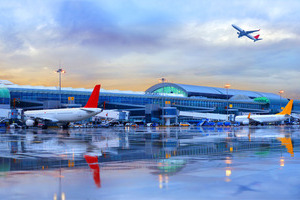The COVID-19 pandemic has brought unprecedented change to airports. Global passenger traffic declined by 94% year-on-year in April 2020, according to Airports Council International.
Even as restrictions ease, numbers remain low. Eurocontrol reported air traffic throughout Europe was 61% down in May 2021 compared to May 2019, says Richard van Wijk, global aviation practice lead inside Nokia.
While traffic isn’t expected to return to pre-COVID levels until 2024, Eurocontrol recently predicted an upward trend and hope for some recovery across Europe this summer, with the most optimistic scenario showing numbers rising to up to 69% of 2019 levels during August.
Airport costs are predominantly fixed. Even with low passenger numbers and declining revenue they need to maintain operations for cargo flights. Operational, maintenance, utility and personnel costs remain constant.
So, how will they manage their economic turnaround and tempt passengers back as countries tentatively reopen borders for international travel? The answer can be found in accelerating digital transformation (DX) programmes, allowing them to leverage automation and enable new services and operational efficiencies.
The connected airport

Tomorrow’s airports will be all about digitalisation, otherwise known as Airport 4.0 , targeting operational excellence, enhanced awareness and greener, safer spaces. Stakeholders will communicate more efficiently and be able to collect data from connected sensors to analyse operations, passenger flow, environmental information and more. To do this cost-effectively and securely, airports will have to re-think their connectivity strategy.
Today airports use a mix of connectivity technologies; copper-based wireline, Wi-Fi and public wireless services. Although these still serve a key purpose in the digital airport, there are concerns over costs, service reliability and flexibility.
To create the connectivity foundation for Airport 4.0, airports should consider 4G and 5G private wireless technology. This will allow them to flexibly and efficiently connect any device, application sensor or sub-system in a secure way inside the terminal, at airside and landside.
Coaxing back passengers
It’s no surprise that even as restrictions lift, some people are wary of traveling. To tempt passengers back, airports must first show how they can keep them safe.
One way is to implement biometrics systems and move toward touchless and ticketless travel. Using sensors and cameras to scan passengers’ features in real time as they navigate the airport can reduce bottlenecks as well as the need for boarding cards or passports decreasing the chance of delays when documents are misplaced.
Another solution is to implement queue monitoring systems and collate passenger numbers from sensors. As queues reach capacity in terms of social distancing or to maintain efficiencies and keep people moving new lanes can be opened automatically.
Private wireless provides the connectivity and low latency capabilities to support the real-time demands of these applications. The ability to collect data from sensors will allow airports to show how they are adhering to COVID regulations and introduce new services more rapidly.
Implementing a sustainable turnaround and enhanced passenger satisfaction
To step away from paper and pencil, airports will have to implement a connectivity service at airside that allows stakeholders to use devices anywhere. Private wireless is a perfect fit, allowing airports to purpose-build a network that ensures coverage and capacity wherever it’s needed, while keeping operational data securely within the airport campus.
Resource planning will be made much more accurate, and aircraft turnaround time will be reduced. Stakeholders will communicate over a single, multiservice network and airport vehicles will become mobile offices, reducing the need to return to base for more sustainable operations.
The extensive coverage enabled by private wireless will also allow airports to connect mobile cameras within vehicles to enhance operational and situational awareness. This will enable airport operation centre teams to enhance decision-making by providing a view of incidents that they don’t currently have using Push-to-Talk radios.
Enhanced operational efficiencies and awareness will also have a positive impact on passenger safety and satisfaction in terms of reduced flight delays and queues inside the terminal. Additionally, as private wireless networks offload operational traffic from Wi-Fi and public networks, capacity is freed up for a better passenger connectivity experience.
Soaring to economic health

Using private wireless, airports will have more flexibility and agility to implement new services. They will be better prepared for a world where restrictions change dramatically, with the ability to not only leverage analytics to show how they are adhering to regulations but also to show customers how they are enhancing services to remain competitive.
As the world reopens, and the aviation industry begins to move on from the effects of COVID-19, airports have the opportunity to spark their economic recovery and transformation using private 4G and 5G wireless networks. By becoming Airport 4.0 digital hubs, they will benefit from extensive new capabilities and operational efficiencies that will streamline costs and help them tempt passengers back to the skies once again.
The author is Richard van Wijk, global aviation practice lead inside Nokia.
Comment on this article below or via Twitter: @IoTNow_OR @jcIoTnow










